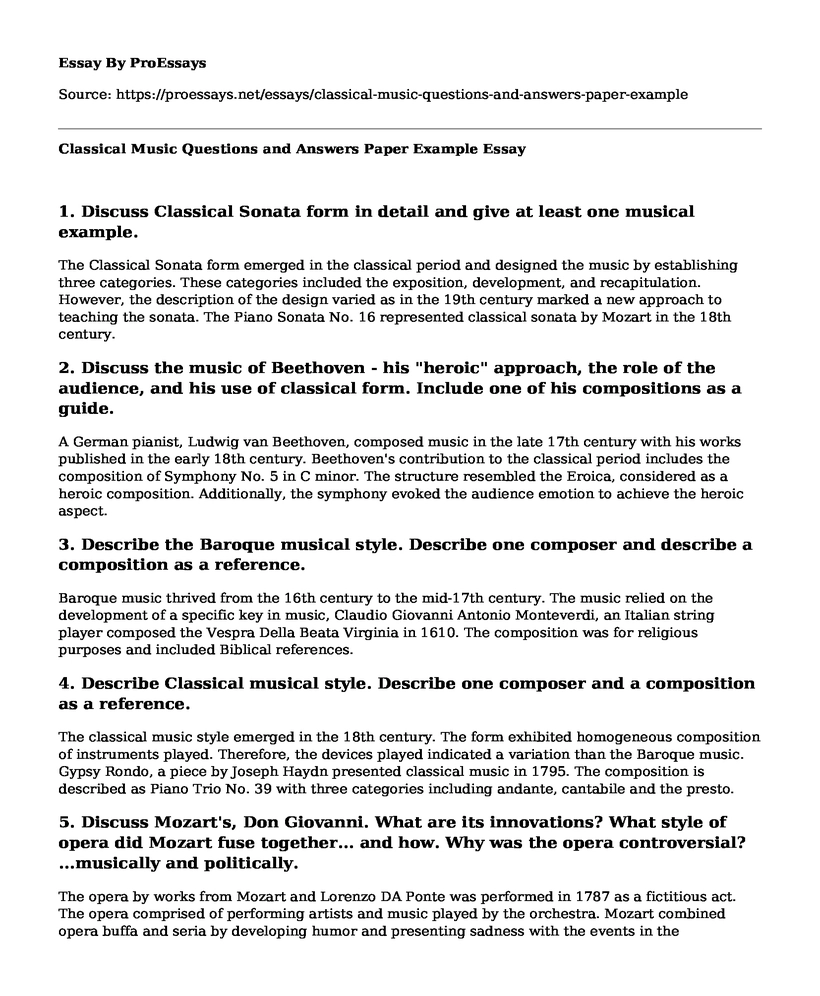1. Discuss Classical Sonata form in detail and give at least one musical example.
The Classical Sonata form emerged in the classical period and designed the music by establishing three categories. These categories included the exposition, development, and recapitulation. However, the description of the design varied as in the 19th century marked a new approach to teaching the sonata. The Piano Sonata No. 16 represented classical sonata by Mozart in the 18th century.
2. Discuss the music of Beethoven - his "heroic" approach, the role of the audience, and his use of classical form. Include one of his compositions as a guide.
A German pianist, Ludwig van Beethoven, composed music in the late 17th century with his works published in the early 18th century. Beethoven's contribution to the classical period includes the composition of Symphony No. 5 in C minor. The structure resembled the Eroica, considered as a heroic composition. Additionally, the symphony evoked the audience emotion to achieve the heroic aspect.
3. Describe the Baroque musical style. Describe one composer and describe a composition as a reference.
Baroque music thrived from the 16th century to the mid-17th century. The music relied on the development of a specific key in music, Claudio Giovanni Antonio Monteverdi, an Italian string player composed the Vespra Della Beata Virginia in 1610. The composition was for religious purposes and included Biblical references.
4. Describe Classical musical style. Describe one composer and a composition as a reference.
The classical music style emerged in the 18th century. The form exhibited homogeneous composition of instruments played. Therefore, the devices played indicated a variation than the Baroque music. Gypsy Rondo, a piece by Joseph Haydn presented classical music in 1795. The composition is described as Piano Trio No. 39 with three categories including andante, cantabile and the presto.
5. Discuss Mozart's, Don Giovanni. What are its innovations? What style of opera did Mozart fuse together... and how. Why was the opera controversial? ...musically and politically.
The opera by works from Mozart and Lorenzo DA Ponte was performed in 1787 as a fictitious act. The opera comprised of performing artists and music played by the orchestra. Mozart combined opera buffa and seria by developing humor and presenting sadness with the events in the performance. Consequently, the opera caused controversy due to the emotions caused to the audience and its timelessness, thus applied in various political generations.
6. Discuss Beethoven's 5th or 9th symphonies (your choice). What compositional elements make them monumental works of art and how are they cyclical.
Beethoven's 9th symphony achieved recognition after a performance in Vienna in 1824. Common practice in the composition resulted in uniformity in melody and the fall of voices. The harmony focuses on the movement, thus influencing the works by other artists. The symphony application in historical events promotes the cyclical nature.
7. Describe, in detail, fugal form (ie. JS Bach). Be sure to highlight the exposition, as well as the points discussed in class.
The fugal form focuses on the musical theme with voices at the start of the music. The instruments start with the various pitches as the voices join to start the music. JS Bach's Toccata and Fugue in 1704 presented the fugal form with the use of Toccata and the fugue. The piece begins with a D minor notation, then arpeggio.
8. Describe an oratorio.
An oratorio comprises of a choir led by a soloist performing a musical piece using instruments. Alesandra Scarlatti's Oratorio per la Santissima Trinita uses the choir to illustrate the struggle between believers and the nonbelievers of the holy trinity. The use of instruments occurs alternatively thus engaging the audience. The piece is recited on a religious basis.
9. Compare opera seria to opera buffa. Compare and contrast their differences and similarities. List at least one example of each.
Opera seria is a musical performance that focuses on serious matters while opera buffa aims to create humor among the audience. Both performances include the use of music in a theatre. However, opera buffa includes daily activities of the community, such as Donizetti's L'elisir d'amore, while opera seria isolates specific incidents for musical performance such as Johann Hasse's Artaserse.
10. Discuss the importance of the patronage system in the Classical Era, and how it helped shape specific musical genres (Haydn would be a great example).
The patronage system requires supervision of the composition and performance of music. The system ensures the stability of the composers by providing the material support necessary for quality compositions. The support of Joseph Haydn by Georg von Reutter introduced him to the musical practice. Count Morzin promoted Haydn to Kapellmeister to oversee church music, thus providing him the opportunity to lead the choir and develop his composition skills.
Cite this page
Classical Music Questions and Answers Paper Example. (2022, Sep 21). Retrieved from https://proessays.net/essays/classical-music-questions-and-answers-paper-example
If you are the original author of this essay and no longer wish to have it published on the ProEssays website, please click below to request its removal:
- The Facebook's Emotional Contagion Study
- Burberry and Dior: A Critical Analysis
- Essay Sample on Music from Kenya in Sub-Saharan Africa
- Composition of the Photography Essay
- Songs Reflect, Depict and Impact Los Angeles - Essay Sample
- Essay Example on Music: Life's Necessity for Moods & Vibes
- Young African Americans: Hopelessness and Fear in a Painting - Free Essay Example







